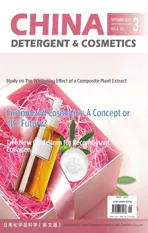Study on The Whitening Effect of a Composite Plant Extract
2023-11-29ZhangHaoTangWendiHuQiumingZhongMeiying
Zhang Hao,Tang Wendi,Hu Qiuming,Zhong Meiying
Guangzhou BINF Co.,Ltd.,China;
Li Yan
Guangzhou Senji Trading Company,China
Wang Yan
Yunnan Evergreen Co.,Ltd.,China
Abstract By compounding the cranberry extract,lavender flower extract,Kakadu plum extract,edelweiss flower/leaf extract and aloe vera extract into a composite plant extract (BIRC-Rosée WT100),the whitening effects of this composite plant extract in antioxidation,anti-inflammation,skin barrier maintenance,and inhibition of melanin production and transport were evaluated.By comparing the inhibitory effects on tyrosinase activity between the composite plant extract and α-arbutin,and then analyzing the decline of apparent chromaticity,apparent brightness and melanin content through 3D melanin skin model platform,the comprehensive whitening effect was evaluated and compared with that of kojic acid.The results showed that,the composite plant extract (BIRC-Rosée WT100) had a tyrosinase inhibition rate of 98.99% at the original concentration,which was much higher than that of α-arbutin.In 3D melanin skin model,the apparent chromaticity and brightness could be effectively improved,and moreover,the total amount of melanin in the skin could be reduced,showing remarkable whitening effect.
Key words whitening effect;composite plant extract;skin barrier;bilberry fruit extract;3D melanin skin model
The whitening effect of cosmetics is one of the most remarkable effects in China and even the whole Asian cosmetics market,and the research on the ways and channels of whitening effect of cosmetics and their raw materials has also been carried out continuously.Because melanin is the main cause of human skin pigmentation,among the research on whitening pathways of cosmetics,the research on preventing and delaying melanin production is the most typical[1].In the early days,the research on the molecular mechanism of whitening active ingredients mostly focused on the mechanism of reducing melanin production and improving skin color.
Besides the whitening mechanism for melanin production and transportation,it can also reduce the increase of melanin secretion and the blackening of skin color caused by skin barrier damage or local slight inflammation by perfecting skin barrier,relieving slight inflammation inside skin and maintaining water balance of skin barrier.According to this mechanism,the wide application of resveratrol in whitening field is promoted[2,3].
With the in-depth study of the relationship between anti-aging and whitening,the close relationship between anti-aging and whitening has been gradually confirmed.In recent years,the antioxidant effect,which was previously considered to be only related to anti-aging,has also been proved to inhibit melanin production.The active components with antioxidant effect have been proved to have the effects of inhibiting tyrosinase activity and scavenging free radicals while delaying skin aging[4].In addition,with the cross-research on anti-aging and melanin inhibition of autophagy,gentle exfoliation,metabolism enhancement and anti-photoaging,the effects of “translucent” and “ruddy” accompanied by the main effects of “anti-aging” are gradually used to establish relationships with whitening-related effects such as “whitening” and “brightening”[5,6].In addition,the protein carbonylation mechanism,which is strongly related to aging,but not related to melanin production and metabolism,is often accompanied by the deposition of various pigments(such as lipofuscin) other than melanin,which appears as the result of yellow and dull skin color[7,8].Therefore,more and more effective active ingredients against melanin are gradually turning their attention to solving the skin color changes that accompany the aging process.
Lavandula Angustifolia is widely distributed in Europe,China and Australia.Lavandula angustifolia flowers contain volatile components such as linalool acetate and eucalyptus leaf brain,which have pharmacological effects such as bacteriostasis,antiinflammation and treatment of nervous system diseases[9].In recent years,researches on lavender flowers have found that lavender flowers are rich in fruit acids and flavonoids besides volatile components.In addition to removing the aged stratum corneum,it can also play an important role in resisting photodamage and eliminating the influence of existing photodamage on the skin through multitarget synergy with PI3K/Akt signaling pathway and NF-κB signaling pathway,and at the same time,it has an important impact on inhibiting melanin synthesis and transport[10].
Vaccinium Macrocarpon,commonly known as cranberry,is an evergreen shrub,which is used as traditional medicine and food by indigenous people in North America.Its fruit contains basic amino acids and biological peptides,mainly arginine,and has the function of repairing oxidative damage and damaged skin barrier[11].Terminalia Ferdinandiana,also known as Kaka DuLi,is a fruit with the highest VCcontent in the world,with a content as high as 5,300 mg/100 g,about 100 times that of orange (53 mg/100 g),and it also contains a lot of ellagic acid and polyphenols,which has excellent antioxidant effect.Leontopodium Alpinum,also known as edelweiss,is the national flower of Switzerland and Austria.The extracts of its flowers and leaves contain chlorogenic acid and edelweiss acid,which have the effects of scavenging free radicals and antioxidation,and the luteolin it contains also has the effect of inhibiting various inflammatory cytokines(such as IL-6,IL-8 and TNF-α).
MelaKutis®3D melanin skin model is a stratified epidermal tissue constructed by human keratinocytes and melanocytes in vitro.Because its tissue is similar to human epidermis structure,and melanocytes can grow normally in the basal layer of the model,the overall structure has a melanin response mechanism and function that is highly close to human skin,and its performance can accurately predict the real whitening effect of the test object on human body.MelaKutis®3D melanotic skin model is of great significance as a human substitute for evaluating whitening effect[12].
In this experiment,cranberry extract,lavender flower extract,Kaka DuLi extract rich in VC,edelweiss extract with antioxidant and antiinflammatory effects and aloe vera extract with moisturizing effect were compounded.In terms of mechanism,it is constructed from the aspects of inhibiting melanin production and transport,maintaining skin barrier,antioxidation,antiinflammation,moisturizing and so on.By studying its inhibitory effect on tyrosinase activity in vitro,and its influence on the comprehensive apparent chromaticity,apparent brightness (L* value) and melanin content of MelaKutis®3D melanin skin model platform,its potential skin whitening effect is verified,which lays a foundation for subsequent product development.
1 Experimental part
1.1 Reagents and instruments
Vaccinium Macrocarpon extract,cosmetic grade,Silab company,France;Lavender flower extract,cosmetic grade,Ashland company,USA;Terminalia Ferdinandiana,cosmetic grade,Southern Cross Company of Australia;Leontopodium Alpinum extract,cosmetic grade,Shanghai Jizhou Chemical Co.,Ltd.;Aloe vera extract,cosmetic grade,Yunnan Wanlv Biological Co.,Ltd.
M-TA melanin model culture medium,MelaKutis®3D melanin skin model (batch number:MS220501),Guangdong Boxi Biological Co.,Ltd.;Sterile PBS buffer solution,American doctor biology;Sodium hydroxide,anhydrous ethanol,diethyl ether and ammonia water: analytically pure,Sinopharm Group;Dimethyl sulfoxide (DMSO)solution,melanin (alcohol soluble,standard),Sigma Company,USA;Phosphate buffer powder,beekman Bio;Polyphenol oxidase (tyrosinase,BR,1,240 U/mg),L-dopa (BR,99%),α-arbutin (99%),kojic acid,Shanghai yuanye Bio-TechnologyCo.,Ltd;The other chemical reagents are all of AR grade.
RW20 agitator,IKA Company,Germany;AR224CN analytical balance,Oside instrument;HF151UV CO2 incubator,Thermo Company,USA;Sujing Antai SW-CJ-1F clean bench,Jiangsu Sujing Group;BioTek Epoch enzyme marker,BioTek Company,USA;Dermalab® Combo colorimeter,Cortex Company,Denmark;HH-4A digital display constant temperature water bath pot,Changzhou Guohua Electric Appliance Co.,Ltd.;Model H1850R low-temperature high-speed centrifuge,Hunan Xiangyi Group.
1.2 Experimental method
1.2.1 Preparation of whitening plant extract combination (BIRC-Rosée whitening essence WT100)
The ingredients of BIRC-Rosée whitening essence WT100 were shown in Table 1.Uniformly mixing and dissolving the components at normal temperature to obtain the final product.
1.2.2 Preparation of positive control sample
2% α-arbutin reference substance: the raw material is powder,the purity is ≥99% (batch number:C08J12H136781).Weigh 200 mg of α-arbutin powder,add 10 mL of phosphate buffer (pH=6.86),and fully dissolve to prepare 2% α-arbutin positive control working solution.
Kojic acid: raw material is powder with purity≥99%(batch number: Y16M7C14816).Weigh 43.67 mg kojic acid powder and add 1 mL DMSO to prepare positive control working solution.
1.2.3 Tyrosinase inhibition experiment
Polyphenol oxidase,also known as tyrosinase,is a key enzyme in the synthesis of melanin,which can catalyze L-dopa to produce dopachrome,and its product has a characteristic absorption peak at λ=475 nm.By measuring the change of tyrosinase content,the inhibition rate of tyrosinase activity of the sample is calculated.
Phosphate buffer solution (pH=6.86): According to the packaging instructions,dissolve a packet of phosphate buffer powder in 250 mL deionized water and stir until it is dissolved.
Levodopa test solution: weigh 39.4 mg levodopa powder and dissolve it in 100 mL phosphate buffer(pH=6.86) to prepare a test solution of 2 mmol/L.
Tyrosinase test solution: Weigh 2 mg of tyrosinase powder and dissolve it in 12.4 mL phosphate buffer (pH=6.86) to prepare 200 U/L tyrosinase test solution.
The sample “BIRC-Rosée Whitening Essence WT100” and the positive control 2% α-arbutin were diluted to 4 times and 16 times with deionized water respectively,and together with the original concentration,three concentration gradients were formed,as shown in Table 2,and the experimental grouping settings were shown in Table 3.
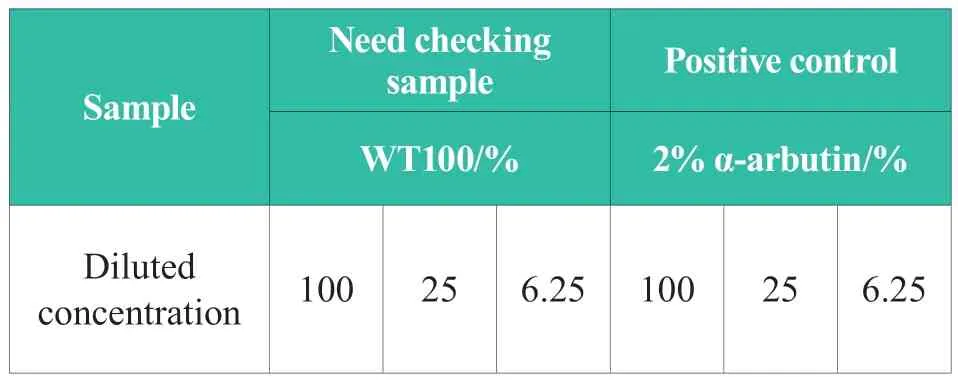
Table 2.Sample solutions for testing the inhibition of tyrosinase activity
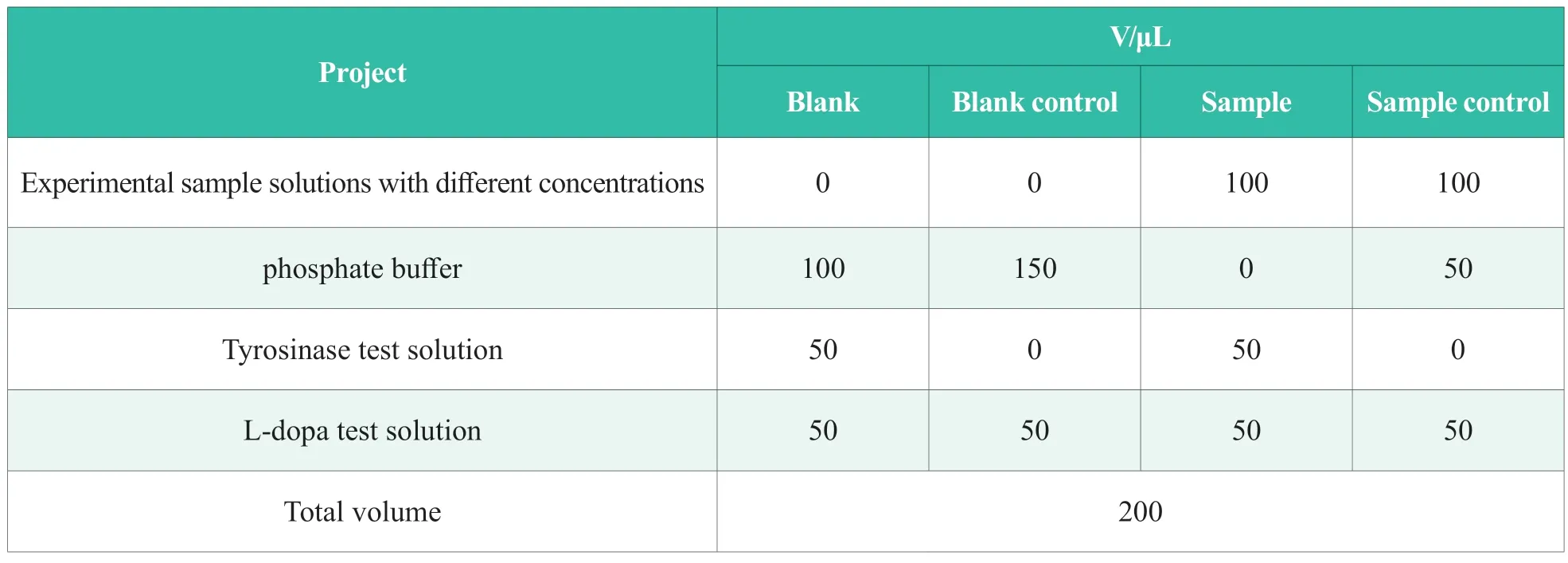
Table 3.Grouping in the experiment of inhibition of tyrosinase activity
According to Table 2 and Table 3,add the experimental sample solutions with different concentrations,corresponding phosphate buffer solution and tyrosinase test solution into a 96-well plate,mix them evenly and incubate at 25 ℃ for 5 min.Then add L-dopa test solution,mix well and incubate at 25 ℃ for 10 min.The absorbance A475 was measured at λ=475 nm by enzyme-labeled instrument,and three multiple holes were set in each group.After detection,the average value of A475 was taken.The tyrosinase inhibition rate of each sample is calculated according to Formula (1):
1.2.4 Evaluation experiment of whitening effect of MelaKutis® 3D melanin skin model
The experiment was conducted with reference to the methods of previous studies.The experiment lasted for 8 days,and 50 mJ/cm2UVB was used to act on MelaKutis®3D melanin skin model every day to construct melanin model.By studying the chromaticity changes after simulated sun exposure and the changes of melanin content in the model,the whitening effect of natural extract combination on skin was evaluated.
The detection model is MelaKutis®3D melanin skin model,and the detection indexes are: apparent chromaticity test (photography method),model L*value test (colorimeter test) and melanin content test(alkali cracking method).The experimental grouping settings are shown in Table 4.

Table 4.Test scheme of the whitening experiment by 3D skin model

Table 5.Inhibition rate on tyrosinase activity for the samples with different concentrations and the positive control group
Model receiving: Prepare 6-well plates according to the test scheme in Table 4,add 3.7 mL M-TA culture solution to each well,pre-cultivate the gas-liquid level in a CO2incubator (37 ℃,5% CO2)for 3 days,receive the model on the third day,and then transfer it to the marked 6-well plate;Each test group needs 3 model wells,and all 6-well plates with models are transferred to a CO2incubator for 8 days(37 ℃,5% CO2),during which the liquid is changed once every 24 h.
Administration and UVB stimulation: The sample group and the negative and positive control groups were irradiated with UVB stimulation at a fixed time every day (50 mJ/cm2,with each irradiation duration of 21 s) from the day of receiving the model,and the sample group and the positive control group were given 10 μL of administration on the 4th and 6th days from the day of receiving the model,respectively,according to the contents in Table 4.
Apparent chromaticity test: After the drug administration process was completely finished (the 8th day),the residual liquid on the tissue surface of each group was carefully absorbed with sterile cotton swabs,and the apparent chromaticity of each group was comparatively tested by taking photos.Under the condition of constant light source,set the parameters of SLR camera to manual photographing mode (focal length 5.8 mm,aperture f/8,aperture F22,shutter speed 1/80 s,ISO 1600 setting),set the ring color comparison card,and put individual models in the color circle of the ring color comparison card to photograph and compare the apparent chromaticity.
L* value test: cut the model from a 6-hole plate along the edge of the chamber,put it on a flat and hard white plane,and put the cuticle upward.Use Dermalab®Combo colorimeter to detect the L* value of each group of models respectively,and repeat the reading for three times to take the average value as the L* value reading of the corresponding experimental group.
Melanin content test: put each group of models in 1.5 mL EP tubes and label them respectively,add 1 mL PBS buffer solution to each tube,shake with vortex shaker for 3 min,centrifuge with low temperature and high speed at 2,000 r/min for 10 min,and discard the supernatant;Add 200 µL distilled water,500 μL anhydrous ethanol and 500 μL diethyl ether to the precipitation part in turn,fully mix them,then let them stand at room temperature for 20 min,then centrifuge at 3,000 r/min for 5 min,and discard the supernatant;thermal incubation: adding 1 mL of 1 mol/L NaOH aqueous solution containing 10% DMSO,blowing several times,and heating in a water bath at 80 ℃ for 40 min;Absorb 200 µL supernatant into the corresponding numbered holes of 96-well plate,and read the absorption value at 405 nm.Test 2 parallel holes on 96-well plate for each model.
Statistical analysis of data: GraphPad Prism was used for drawing,and the result was expressed as Mean±SD.T-test statistical analysis was used for comparison among groups.Statistical analysis is double-tailed.P<0.05 indicates a significant difference,andP<0.01 indicates a very significant difference.
2 Results and discussion
2.1 Inhibitory rate of tyrosinase activity
Table.5 shows the inhibitory rate of tyrosinase activity in different concentrations of WT100 and positive control group (2% α-arbutin).
2.2 Whitening efficacy detection based on 3D melanin skin model (MelaKutis®)
2.2.1 Apparent chromaticity improvement
The improvement effect of apparent chromaticity of samples and control groups is shown in Figure 1.As can be seen from Figure 1,compared with NC group,the apparent chromaticity of sample WT100 is obviously improved.At the same time,compared with BC group,the apparent chromaticity of negative control NC group was obviously black,which indicated that the UV stimulation conditions in this experiment were effective.Compared with NC group,the apparent chromaticity of PC (kojic acid) group was obviously improved,which indicated that the positive control test was effective.

Figure 1. Improvement of apparent chromaticity
2.2.2 Apparent brightness (L* value) detection
The detection results of apparent brightness(L* value) of samples and control groups are shown in Table 6.As can be seen from Table 6,compared with NC group after UVB stimulation,the apparent brightness (L* value) of the sample group after the action of the sample “WT100” increased significantly,and the trend was consistent with the experimental results described in 2.2.1,suggesting that the sample“WT100” has a remarkable whitening and brightening effect.At the same time,compared with BC group,the apparent brightness (L* value) of NC decreased significantly,which indicated that the stimulation conditions in this experiment were effective.Compared with NC group,the apparent brightness (L*value) of PC (kojic acid) group increased significantly,indicating that this positive control test is effective.

Table 6.Test results of apparent brightness (L* value)
2.2.3 Detection of melanin content in 3D melanin skin model
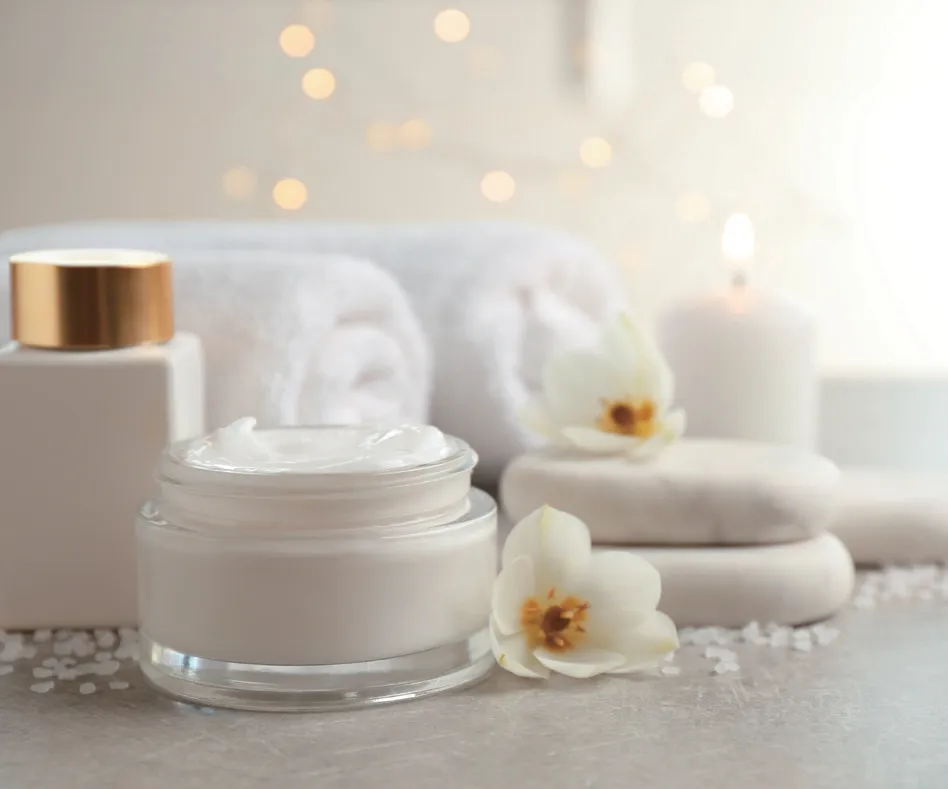
The test results of melanin content in each experiment and control group model are shown in Table 7.The detection results of melanin content in the 3D melanin skin model showed that compared with the NC group stimulated by UVB,the melanin content in the model of the sample group after the action of the sample “WT100” decreased significantly,which once again confirmed that the sample “BIRC-Rosée whitening essence WT100”had a remarkable whitening and brightening effect.Compared with BC group,the melanin content of NC model increased significantly,which indicated that the stimulation conditions in this experiment were effective.Compared with NC group,the melanin content in PC (kojic acid) group decreased significantly,indicating that this positive control test is effective.
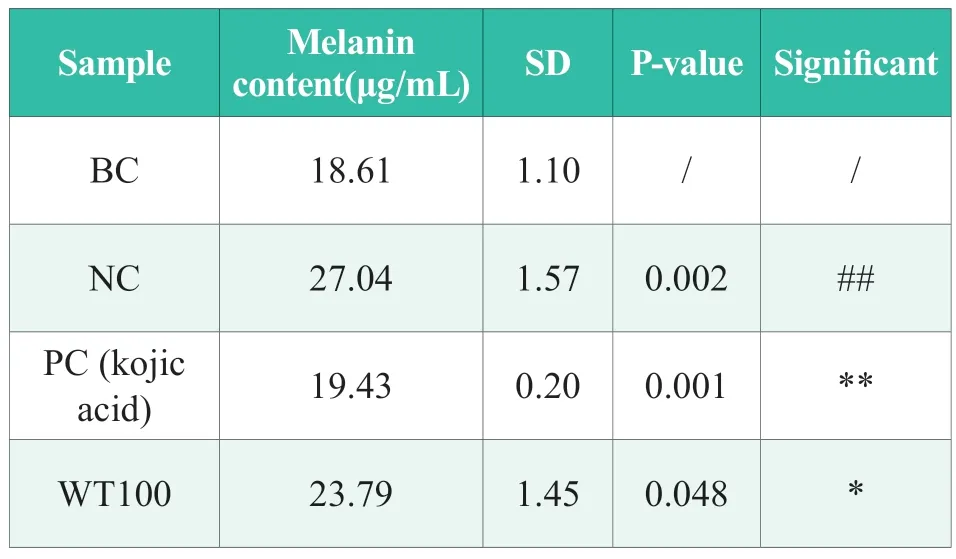
Table 7.Results of melanin content by 3D skin model
3 Conclusion
By detecting the inhibition of tyrosinase activity of the sample,the effect on melanin production was preliminarily studied.Compared with α-arbutin,a commonly used whitening ingredient in cosmetic formula (the conventional addition amount is less than 2%),it was found that “BIRC-Rosée Whitening Essence WT100” had better inhibition on tyrosinase activity than the positive control (2% α-arbutin).
MelaKutis®3D skin model method was used to evaluate the objective influence of the sample on melanin and the overall whitening effect.Combined with the inhibitory results of tyrosinase activity in vitro,it was confirmed that the whitening plant extract combination “BIRC-Rosée whitening essence WT100” could effectively improve the apparent chromaticity and brightness,and at the same time reduce the total amount of melanin in the skin,with remarkable whitening effect.

